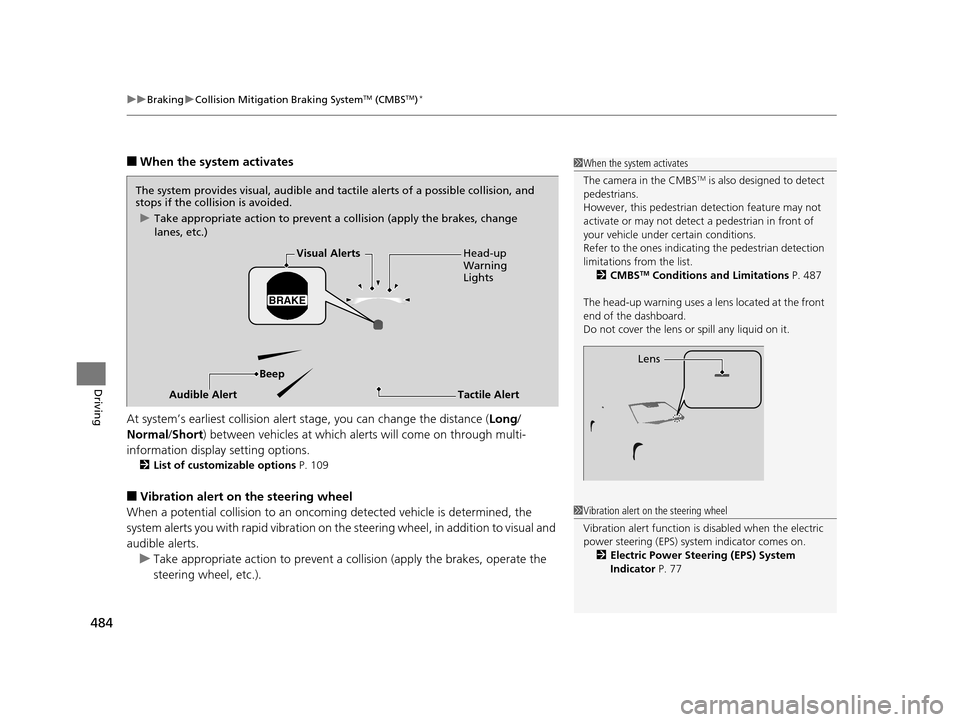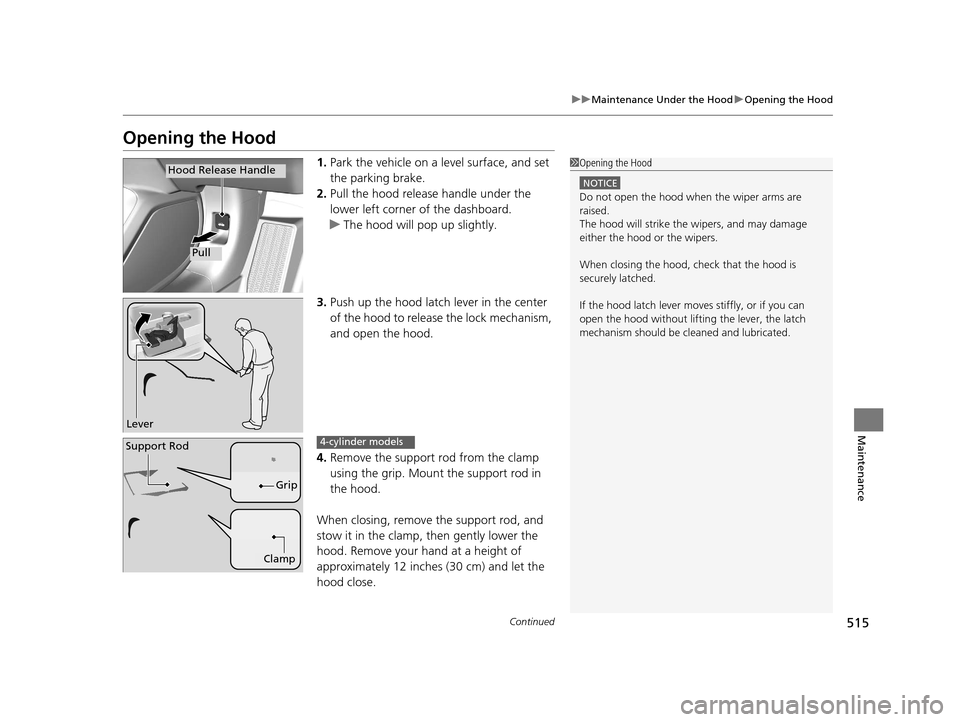Page 483 of 609
482
uuBraking uBrake Assist System
Driving
Brake Assist System
Designed to assist the driver by generating greater braking force when you depress
the brake pedal hard during emergency braking.
■Brake assist system operation
Press the brake pedal firmly for more powerful braking.
When brake assist operates, the pedal ma y wiggle slightly and an operating noise
may be heard. This is normal. Keep holding the brake pedal firmly down.
■Brake Assist System
16 US ACCORD 2D (KA KC KL)-31T3L6300.book 482 ページ 2015年7月23日 木曜日 午後4時11分
Page 485 of 609

uuBraking uCollision Mitigation Braking SystemTM (CMBSTM)*
484
Driving
■When the system activates
At system’s earliest collision alert stage, you can change the distance ( Long/
Normal /Short) between vehicles at which aler ts will come on through multi-
information displa y setting options.
2List of customizable options P. 109
■Vibration alert on the steering wheel
When a potential collision to an oncoming detected vehicle is determined, the
system alerts you with rapid vibration on the steering wheel, in addition to visual and
audible alerts.
u Take appropriate action to prevent a collision (apply the brakes, operate the
steering wheel, etc.).
1When the system activates
The camera in the CMBS
TM is also designed to detect
pedestrians.
However, this pedestrian detection feature may not
activate or may not detect a pedestrian in front of
your vehicle under certain conditions.
Refer to the ones indicating the pedestrian detection
limitations from the list. 2 CMBS
TM Conditions and Limitations P. 487
The head-up warning uses a lens located at the front
end of the dashboard.
Do not cover the lens or spill any liquid on it.
Lens
The system provides visual, audible and tactile alerts of a possible collision, and
stops if the collision is avoided.
u Take appropriate action to prevent a collision (apply the brakes, change
lanes, etc.)
Beep Head-up
Warning
Lights
Visual Alerts
Audible Alert
Tactile Alert
1 Vibration alert on the steering wheel
Vibration alert function is disabled when the electric
power steering (EPS) system indicator comes on.
2 Electric Power Steering (EPS) System
Indicator P. 77
16 US ACCORD 2D (KA KC KL)-31T3L6300.book 484 ページ 2015年7月23日 木曜日 午後4時11分
Page 489 of 609

488
uuBraking uCollision Mitigation Braking SystemTM (CMBSTM)*
Driving
■Vehicle conditions
• Headlight lenses are dirty or the headlights are not properly adjusted.
• The outside of the windshie ld is blocked by dirt, mud, leaves, wet snow, etc.
• The inside of the windshield is fogged.
• An abnormal tire or wheel condition (wrong sized, varied size or construction,
improperly inflated, comp act spare tire, etc.).
• When tire chains are installed.
• The vehicle is tilted due to a heav y load or suspension modifications.
• The camera temperature gets too high.
• Driving with the parking brake applied.
• When the radar sensor at the lower part of the front bumper gets dirty.
■Detection limitations
• A vehicle or pedestrian suddenly crosses in front of you.
• The distance between your vehicle and the vehicle or pedestrian ahead of you is
too short.
• A vehicle cuts in front of you at a slow speed, and it brakes suddenly.
• When you accelerate rapidly and approach the vehicle or pedestrian ahead of you
at high speed.
• The vehicle ahead of you is a motorcycle, bicycle, mobility scooter or other small
vehicle.
• When there are animals in front of your vehicle.
• When you drive on a curved, wi nding or undulating road that makes it difficult for
the sensor to properly detect a vehicle in front of you.
• The speed difference between your vehicle an d a vehicle or pedestrian in front of
you is significantly large.
• An oncoming vehicle suddenly comes in front of you.
• Another vehicle suddenly comes in front of you at an intersection, etc.
• Your vehicle abruptly crosses over in front of an oncoming vehicle.
• When driving through a narrow iron bridge.
• When the lead vehicle suddenly slows down.
16 US ACCORD 2D (KA KC KL)-31T3L6300.book 488 ページ 2015年7月23日 木曜日 午後4時11分
Page 502 of 609

501
Maintenance
This chapter discusses basic maintenance.
Before Performing MaintenanceInspection and Maintenance ............ 502
Safety When Performing Maintenance .... 503Parts and Fluids Used in Maintenance Service ........................................... 504
Maintenance Minder
TM..................... 505
Maintenance Under the Hood
Maintenance Items Un der the Hood .... 513Opening the Hood ........................... 515
Recommended Engine Oil ................ 517
Oil Check ......................................... 518
Adding Engine Oil ............................ 520
Changing the Engine Oil and Oil Filter..... 521
Engine Coolant ................................ 523
Transmission Fluid ............................ 525
Brake/Clutch Fluid ............................ 527
Refilling Window Washer Fluid......... 528
Replacing Light Bulbs ....................... 529
Checking and Maintaining Wiper
Blades .......................................... 535
Checking and Maintaining Tires
Checking Tires ................................. 537
Tire and Loading Information Label ..... 538Tire Labeling .................................... 538DOT Tire Quality Grading (U.S. Vehicles) ...... 540Wear Indicators................................ 542 Tire Service Life ................................ 542
Tire and Wheel Replacement ........... 543
Tire Rotation .................................... 544
Winter Tires ..................................... 545
Battery ............................................... 546
Remote Transmitter Care
Replacing the Button Battery ........... 547
Climate Control System Maintenance.... 549CleaningInterior Care .................................... 550
Exterior Care.................................... 552
16 US ACCORD 2D (KA KC KL)-31T3L6300.book 501 ページ 2015年7月23日 木曜日 午後4時11分
Page 503 of 609

502
Maintenance
Before Performing Maintenance
Inspection and Maintenance
For your safety, perform all listed inspections and maintenance to keep your vehicle
in good condition. If you become aware of any abnormality (noise, smell, insufficient
brake fluid, oil residue on the ground, etc.), have your vehicle inspected by a dealer.
(Note, however, that service at a dealer is not mandatory to keep your warranties in
effect.)
■Daily inspections
Perform inspections before long distance tri ps, when washing the vehicle, or when
refueling.
■Periodic inspections
• Check the brake fluid level monthly.
2 Brake/Clutch Fluid P. 527
•Check the tire pressure monthly. Examin e the tread for wear and foreign objects.
2Checking and Maintaining Tires P. 537
•Check the operation of the exterior lights monthly.
2 Replacing Light Bulbs P. 529
•Check the condition of the wiper bl ades at least every six months.
2Checking and Maintaining Wiper Blades P. 535
■Types of Inspection and Maintenance
1Inspection and Maintenance
Maintenance, replacement, or repair of
emissions control devices and systems may be
done by any automotive repair establishment or
individuals using parts that are “certified” to
EPA standards.
According to state and fede ral regulations, failure to
perform maintenance on the maintenance main
items marked with # will not void your emissions
warranties. However, all ma intenance services should
be performed in accordan ce with the intervals
indicated by the information display
*/multi-
information display*.
2 Maintenance Service Items P. 507, 511
If you want to perform complex maintenance tasks
that require more skills a nd tools, you can purchase a
subscription to the Service Express website at
www.techinfo.honda.com.
2 Authorized Manuals P. 593
If you want to perform ma intenance yourself, make
sure that you have the necessary tools and skills first.
After performing ma intenance, update the records in
the separate maintenance booklet.
U.S. models
* Not available on all models
16 US ACCORD 2D (KA KC KL)-31T3L6300.book 502 ページ 2015年7月23日 木曜日 午後4時11分
Page 514 of 609
513Continued
Maintenance
Maintenance Under the Hood
Maintenance Items Under the Hood
4-cylinder models
Brake Fluid
(Black Cap)
Engine Coolant
Reserve Tank Radiator Cap
Washer Fluid
(Blue Cap) Engine Oil Dipstick
(Orange)
Clutch Fluid
(Light Gray Cap)
Engine Oil Fill Cap
Battery
Manual transmission
models
16 US ACCORD 2D (KA KC KL)-31T3L6300.book 513 ページ 2015年7月23日 木曜日 午後4時11分
Page 515 of 609
514
uuMaintenance Under the Hood uMaintenance Items Under the Hood
Maintenance
6-cylinder models
Engine Oil Dipstick
(Orange)
Washer Fluid
(Blue Cap)
Engine Coolant
Reserve Tank
Radiator Cap Brake Fluid
(Black Cap)
Engine Oil Fill Cap
Battery
Clutch Fluid
(Light Gray Cap)
Manual transmission
models
16 US ACCORD 2D (KA KC KL)-31T3L6300.book 514 ページ 2015年7月23日 木曜日 午後4時11分
Page 516 of 609

515
uuMaintenance Under the Hood uOpening the Hood
Continued
Maintenance
Opening the Hood
1. Park the vehicle on a level surface, and set
the parking brake.
2. Pull the hood release handle under the
lower left corner of the dashboard.
u The hood will pop up slightly.
3. Push up the hood latch lever in the center
of the hood to release the lock mechanism,
and open the hood.
4. Remove the support rod from the clamp
using the grip. Mount the support rod in
the hood.
When closing, remove the support rod, and
stow it in the clamp, then gently lower the
hood. Remove your hand at a height of
approximately 12 inches (30 cm) and let the
hood close.1 Opening the Hood
NOTICE
Do not open the hood when the wiper arms are
raised.
The hood will strike the wipers, and may damage
either the hood or the wipers.
When closing the hood, check that the hood is
securely latched.
If the hood latch lever moves stiffly, or if you can
open the hood without lifti ng the lever, the latch
mechanism should be cleaned and lubricated.
Hood Release Handle
Pull
Lever
Support Rod
Grip
Clamp
4-cylinder models
16 US ACCORD 2D (KA KC KL)-31T3L6300.book 515 ページ 2015年7月23日 木曜日 午後4時11分